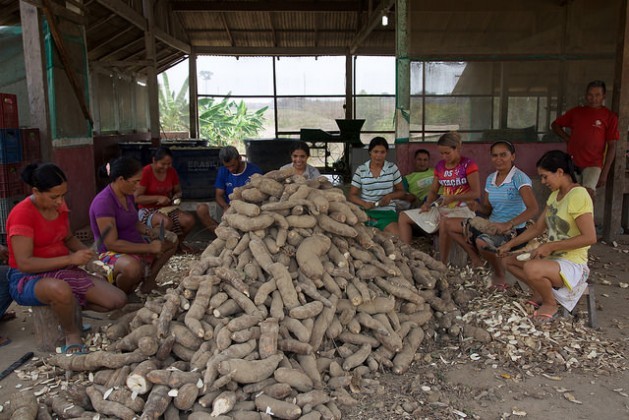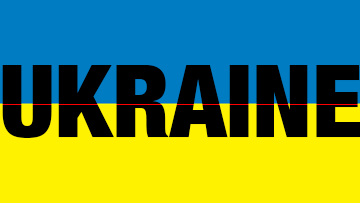The BR-163 highway, along the 100-km route from Santarém, the capital of the municipality of that name, to Belterra runs through an endless stretch of plowed fields, with only a few isolated pockets of the lush rainforest that used to cover this entire area.
State-of-the-art tractors and other farm machinery, a far cry from the rudimentary tools used by the local small farmers in the surrounding fields, are plowing the soil this month, ahead of the planting of soy in January.
José de Souza, a small farmer who owns nine hectares in the rural municipality of Belterra, sighs.
“Soy benefits the big producers, but it hurts small farmers because the deforestation has brought drought,” he tells IPS. “The temperatures here were pleasant before, but now it’s so hot, you can’t stand it.”
The effects are visible in his fields of banana plants, which have been burnt by the hot sun.
Resigned, De Souza waters a few sad rows of straggling cabbages and scallions.
Like other farmers, he has been hemmed in by the expansion of soy in the municipalities of Santarém and the nearby Belterra and Mojuí dos Campos.
According to the Santarém municipal government, of the 740,000 cultivable hectares in this region, soy now covers 60,000.
But Raimunda Nogueira, rector of the Federal University of Western Pará, offers a much higher figure. “Land-use change has involved 112,000 to 120,000 hectares, which have been turned into soy plantations,” she tells IPS.
And with the soy came the spraying.
“The soy fields bring a lot of pests because the poison they use to fight them drives them off their plantations onto our small fields,” laments De Souza.
The agrochemicals have polluted the soil and poisoned crops and animals, local farmers complain.
“The crops die, and as a result the property becomes completely unproductive – and the solution is to sell,” Jefferson Correa, a representative of the local non-governmental organisation Fase Amazonia, tells IPS.
There are no epidemiological data. But in these rural municipalities, the widespread perception is that health problems like respiratory and skin ailments have become more common.
According to Selma da Costa with the Rural Workers Union of Belterra, the threats to their health and the temptation to sell their land have led 65 percent of local small farmers to leave the municipality, which had a population of 16,500.
“They end up leaving, because who is going to put up with the stench of the pesticides? No one. People are getting sick. Pregnant women often feel ill and they don’t know why,” she tells IPS.

“They sold their land for a pittance. They practically gave away their land to the big producers, thinking their lives would get better, that they would build a nice house in Santarém But they can’t support themselves because they can’t grow anything,” she explains.
Correa points out that back in 2000, land here was cheap. There were people who sold 100 hectares for 1,000 to 2,000 dollars, and later regretted it.
“They went to the city, spent all the money, and without any formal education, the only solution was to go back to work in the countryside, as rural labourers for the people who had bought their land,” he says.
Others scrape by on the outskirts of Santarém as street vendors or in other informal sector activities.
“The farmers had their property, their own food, like beans, rice, flour and what they could fish and hunt; but in the city they no longer have that,” adds Claudionor Carvalho with the Federation of Agricultural Workers of the State of Pará.
The change, he explains to IPS, has fuelled prostitution in the slums surrounding the city, “because the families weren’t prepared for what they would face.”
The process was accentuated 15 years ago, with the construction of a port facility in Santarém by the US commodities giant Cargill.
Through the new port terminal in Santarém, on the banks of the Tapajós River where it runs into the Amazon River, soy and other grains can be exported to the Atlantic Ocean.
The aim was to reduce the distance and the costs of transporting soy from the neighbouring state of Mato Grosso, Brazil’s biggest producer.
Brazil is the world’s second-largest producer and leading exporter of soy, which it sells to China, Europe and other markets.
Ports like this one in the Amazon basin have nearly cut in half the transport distance from Mato Grosso, which is around 2,000 km from the congested ports in the southeast, such as Santos in the state of São Paulo.
The new Amazon port, with silos that now have a total capacity of 120,000 tons – double the initial capacity – has drawn hundreds of soy producers from the south of the country, leading to a land-buying stampede and driving up property prices.
One of those who came with his family was Luiz Machado, from Mato Grosso.
“We had 90 hectares that we sold to buy a bigger farm here because the land was cheap,” he tells IPS. “Besides, we would be closer to the port, so we could get a better price for our product.”
Machado says the purchase was legal, and that he has left untouched the rainforest surrounding his property, much of which had already been deforested.
But many others did not do this, and the expansion of soy has devastated large swathes of forest, Cándido Cunha with the National Institute of Colonisation and Agrarian Reform explains in a conversation with IPS.
In 2006, in a “soy moratorium,” associations of producers, many of whom had ties to Cargill, pledged not to sell any more soy from deforested areas.
There was a temporary drop in deforestation. But it once again increased because the farmers that sold their land cleared property in other areas.
“What happened was what we call ‘grillaje’ of land: forged documents or illegal appropriation of public land,” which further complicated the already highly irregular land tenure situation in the Amazon region, says Cunha.
Of the two million and a half tons of soy exported annually from Santarém, just six percent is locally grown; the rest comes from Mato Grosso.
But Nelio Aguiar, secretary of planning in Santarém, says it helped modernise the economy, fomenting a shift from family farming to mechanised agriculture.
“Today we have larger scale, dollarised agriculture, and every harvest produces great riches,” he tells IPS.
But while some celebrate the expansion of agribusiness here, others are worried about the future of local food security.
The greater metropolitan region, population 370,000, depends on family farming for 70 percent of the local food supply.
“Now you have to buy everything in the market, even rice and beans – things we didn’t have to buy before because we produced everything ourselves. And we also sold what we produced,” complains De Souza.
“Why are we buying? Because we don’t have land anymore. And what we plant is being poisoned,” says Da Costa.
For Correa, one solution is to expand government programmes that support family farming. De Souza is a beneficiary of one of them.
Another solution is to join together in farming associations or cooperatives.
De Souza proudly takes IPS to the São Raimundo do Fe em Deus cooperative, of which he is a member, where a festive group of men and women are sharing the tasks of peeling, grating and cooking manioc to make the flour that is a staple food in Brazil.
“We have to help each other, because small farmers face a difficult situation today,” he says.
Edited by Estrella Gutiérrez/Translated by Stephanie Wildes
Related IPS Articles
- Organic Cacao Farmers Help Reforest Brazil’s Amazon Jungle
- Oil Palm Expands on Deforested Land in Brazil’s Rainforest
- Straightening Out Accounts on Deforestation in the Brazilian Amazon
*Fabiana Frayssinet‘s article was published in IPS on 8 December 2015. Go to Original.
2015 Human Wrongs Watch










